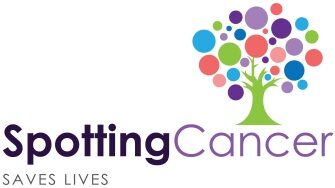How To Be Proactive In Beating Cancer Instead Of Being Fearful Of It
So, as much as it is valid and reasonable for you to feel fearful, anxious, and overwhelmed at the thought of going to the doctor, the best way to beat cancer is to catch it early. This means that you need to take proactive steps in getting the proper diagnosis as soon as possible, including coming in for screening, exploring your treatment options, and starting treatment right away – and all of these steps require you to make an appointment with your doctor.
Cancer grows 24/7 and does not stop until there is some type of medical intervention. Each day that you delay getting treated reduces your survival rate. Remember, the doctor is on your side to beat cancer.
Download Our Spot and Survive Guides Free Now!
Learn the signs to potentially save yours and your family’s life.
Understandably, many people feel that they can’t talk about cancer freely because, among other reasons, they feel like they are to blame for getting cancer in the first place.
But, unhealthy lifestyle choices and guilt aside, many perfectly healthy people are still at risk for many types of cancers, especially if it runs in the family. Also, no matter what our lifestyle choices are, no one asks for cancer to happen to them. And your doctor understands how cancer works more than anyone and will be the last person to blame you regardless of how you feel about it.
If you have an open discussion with your doctor and talk about your concerns, this will help break the stigma and get you on the path to wellness. If you also feel that you’re at risk for cancer, they can help you trace your family history and discuss the possibility of genetic testing.
This blog is not meant to detail various steps you can take to reduce the possibility of getting cancer. It is designed to inform you of the steps to be proactive in early cancer detection and timely treatment instead of being fearful.
1. Establish your medical team now.
It is easier to select a medical team when there is no crisis. This gives you time to research for providers you trust, have confidence in, and with whom you have established a rapport. When you are sick or need immediate medical attention, you want to be comfortable seeing someone you know and trust and, even more importantly, someone who knows YOU and your medical history. It is easier to obtain a timely appointment or referral if you are a regular patient. You need the ability to schedule regular doctor visits, routine testing, and imaging that can help catch small problems before they become serious. The medical team will maintain your baseline in their records. (We have provided a baseline form for you to complete and use as a reference to monitor your body).
How to find a primary care doctor
- Check with your insurance carrier to see if you have to choose a primary caregiver from a specific network based on your policy.
- Ask friends and family for recommendations.
- Ask your local pharmacy, medical emergency center, or hospital.
- If moving, get a referral from your current physician.
2. Chart your family cancer history to know if you are at risk!
Family members share the same genes. You cannot change your genetic makeup. Knowing your family history can help manage your long-term wellness.
Today it is estimated that 5 to 10 percent of all cancers are genetically related. To assist the medical team in evaluating you and deciding which tests and screenings you should have and at what age to start, it is essential that they know your biological family cancer history.
Get to know your family history
Going over your family medical history can help you understand your cancer risk and can even help you beat the disease. Get to know your history today!
- Fill out a Biological Family Cancer History Chart for three biological generations. If you are adopted, ask your adoptive parents if they have any medical information from your biological parents.
- Work with your biological family members to get accurate information such as which relative had cancer, how many times, age when each cancer was diagnosed, type of cancer, and how many years in remission. For any family member with a second diagnosis of cancer, the adjacent set of columns should be completed in order to record it separately. Any additional occurrences need to be completed in section two of the form.
- Give a copy of your completed Biological Family History Chart to your medical team and family members.
3. Develop A Monitoring Program With Your Medical Team.
Screenings and testings are an integral part of early cancer detection. Your doctor will recommend a frequency schedule for you based on your risk factors and family history. Most cancers are now curable if detected early enough. Monitor your body regularly for cancer signs and symptoms and make it your responsibility to schedule timely doctor visits, screenings, and visual tests.
- Determine with your primary doctor if you will need special testing or monitoring. This should include specific information on the type of tests and screenings you should have, how frequently you should schedule them, including doctor visits.
- Discuss the pros and cons of genetic testing for you and your biological family.
- Discuss any uncertainty about monitoring your body on a regular basis. Make sure you understand the signs and symptoms of early cancer detection and how to spot them.
4. Do Not Self-Evaluate.
It’s tempting to imagine all sorts of terrible possibilities, but like with anything in life, if you think about it more than you should, it will only make things worse. Going online to Dr. “Google” for analysis may lead you to further unnecessary anxiety and a wrong conclusion.
Instead, distract yourself from it as much as possible. Think about other things or try doing something fun or different from what you usually do.
If you have an appointment coming up, try to think of your visit ahead of time as just another appointment rather than something terrifying that’s going to happen to you on an unpredictable day in the future. However, if it makes you feel better, have your spouse, a close friend or a family member accompany you to your appointment. Whatever it takes to make you feel better, do that. The important thing is that you show up.
In short, don’t obsess over what might happen at your appointment because worrying won’t help anything.
5. Build a support system.
If there’s one other scary thing that breeds fear, it’s a sense of isolation. Fear and anxiety make you feel alone, hopeless, and like there’s no one there to support you.
While it’s valid to feel this way – as early cancer detection advocates, we also know that this simply isn’t true. You may feel alone, but you aren’t. Whether you’ve gotten a diagnosis yet or not, you can start opening up to those closest to you about your thoughts and give your fears a voice.
When you name your fears, it becomes something real, tangible, and controllable. In addition, when you’re able to share and talk about your fears with others, it eases the burden.
However, if you’re not quite ready to share what you’re going through with friends or family, you can seek out counseling. Your doctor should be able to direct you to the right cancer counselor whom you can speak to in confidence.
You can also find online support groups and other social media groups that can help you, as well.
On that note, let’s move on to the next and final tip.
6. Join the Cancer Detection Squad.
We’ll round up this list of practical tips by inviting you to join the squad – Spotting Cancer’s Cancer Detection Squad.
It’s free to join and you’ll be part of a movement that takes proactive steps in helping reduce cancer deaths through early detection and timely treatment. You will be provided information, methods, and tools to monitor your body on a regular basis, especially between doctor visits or scheduled screenings. Members are knowledgeable and vigilant about cancer monitoring and are empowered to become informed advocates to spread the #SpotandSurvive message of early cancer detection.
Help save lives! You can sign up for free here: spottingcancer.org/cancer-detection-squad/
In Summary
This information is intended as general information only. It was not written or intended as a substitute for medical advice. Please seek professional advice from your physician before taking any action that could affect your health.

